A Fast Tour of Japan's Car Culture
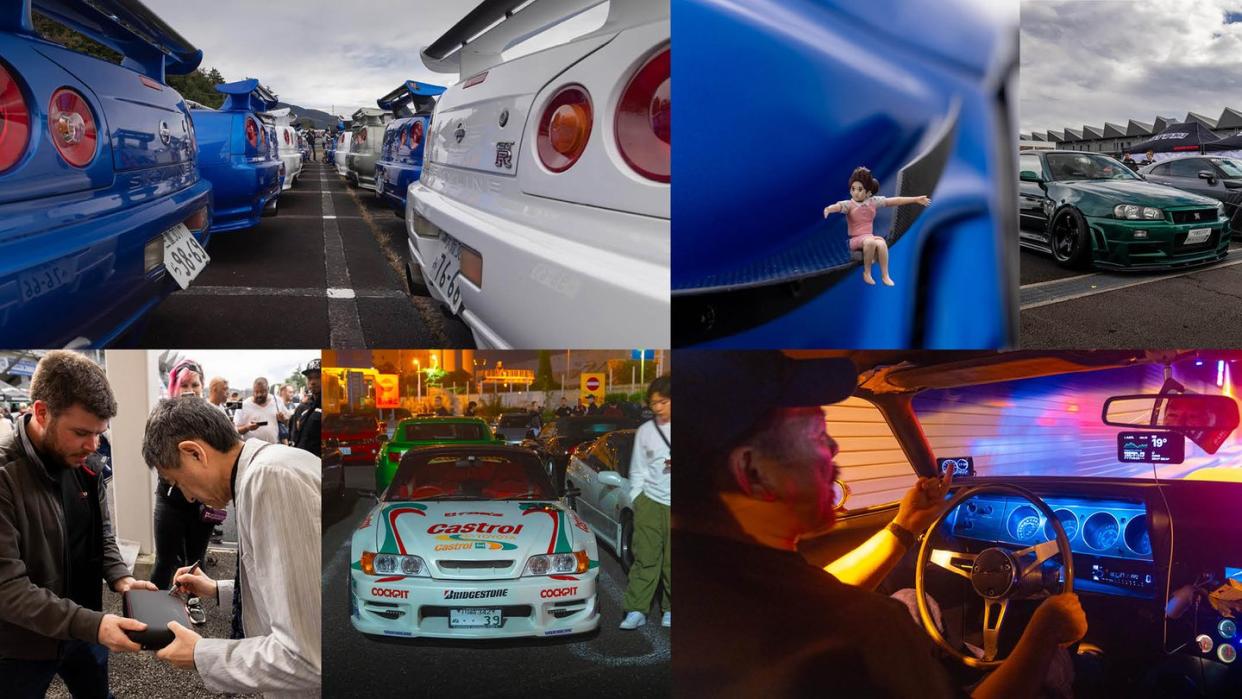
From the May/June issue of Car and Driver.
Of all the things I expected to learn in Japan, the size of the spiders wasn't on the list. "Really big," warned photographer Mike Shaffer, an American expat living in Tokyo, as we boarded a train headed for Fuji Speedway. "I'm afraid of spiders," he added. Three train rides and one bus trip later, I regret to inform arachnophobes that Shaffer's assessment is true. On the walk to the speedway entrance, we saw some creatures bigger than a Honda N-Box. The walk of horror was worth it, though, because once we got to the paddock, we were rewarded with hundreds of Nissan GT-Rs, Japan's most coveted car.
We were there for R's Meeting, an annual gathering of the Nissan muscle cars. There were Skylines visible to the skyline, including long-forbidden '90s models, unavailable to U.S. collectors until recently due to import laws. At home, it's rare to see a mid-'90s fourth-generation Skyline GT-R R33 or a turn-of-the-century fifth-gen R34. At R's Meeting, that's just the overflow parking lot. Inside were even rarer cars: GT-Rs turned to artworks, with anime wraps, candy paint jobs over etched metal, and bare carbon fiber, or thrumming with track focus, like NISMO models with full race tunes and intricate aftermarket bodywork. An R34 in a color-changing hue shifted from pomegranate to gloaming blue as we walked by. Owners personalize their cars—we saw rhinestone badges, louvered hoods, and even a glued-on plastic surfer on a carbon-fiber wheel spat—and let the mods speak for them. Nobody was hanging around their vehicle. Instead, they were strolling the midway, admiring the extreme customizations from well-known tuners or stocking up on beer and fried snacks like takoyaki and gyoza on their way to the grandstands to watch racing with the dramatic backdrop of snowcapped Mount Fuji.
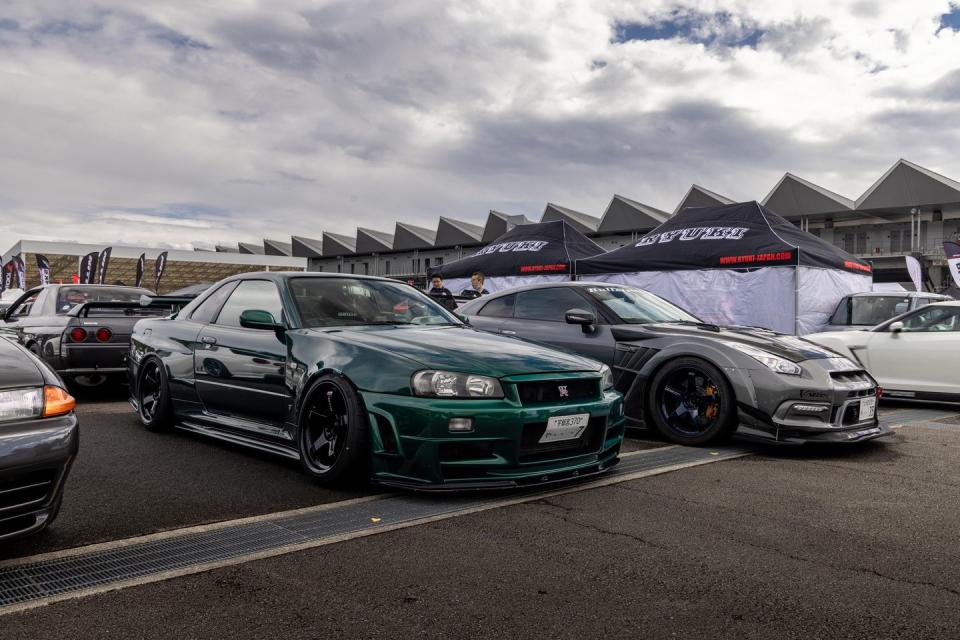
R's Meeting is not an official Nissan event, but there was plenty of factory presence. Nissan's senior vice president of global design, Alfonso Albaisa, attended with his family but took time to talk about how much he enjoys seeing the way fans have tweaked and tuned the GT-R over its 55-year life span (longer if you start from the Prince Skyline of the 1950s). For a designer, "the freeing thing about the GT-R is that it doesn't have to be beautiful," he said, pointing out the car's chunky angles and seemingly unrelated influences. "The side view is Japan; the roof is London; the rear, California. Normally, a designer would say that's confusing, but we're not chasing beauty. We're chasing presence. Each GT-R is different. It has to have a little of the brick-shaped sedan that led Porsche in the 1964 Japanese Grand Prix, but otherwise, there's nothing saying, 'This is what a GT-R is.'"
For Hiroshi Tamura, who is considered the father of the modern GT-R for his work on the R34 and the 370Z (he's known by the honorific Tamurasan even in English-speaking circles) and now serves as a brand ambassador for Nissan, the GT-R is an escape from the dull parts of daily life. "For fundamental transport, get a kei car," he said. "Nothing wrong with a kei car. Get a minivan. It's okay to be efficient. But life is not only an efficiency story. We need emotion." Tamura doesn't just speak; he acts out the story as he tells it. He hunches over, curling his arms around an imaginary steering wheel when he describes the GT-R as a mechanical suit that allows the driver to be a commander, at one with the machine, yet requires so much concentration that there's no room for the boring thoughts of everyday life. "You know the difference between humans and animals?" he asked. "Animals can't drive. To drive makes us human."
If R's Meeting represents some of the best of Japan's automaking history, then late-night scenes in Tokyo showcase the diversity of its contemporary car culture. A visit to Japan for a car enthusiast is like a trip to the Galápagos for a birder. You will see things you never knew existed, tripling your life-list entries in a single day.
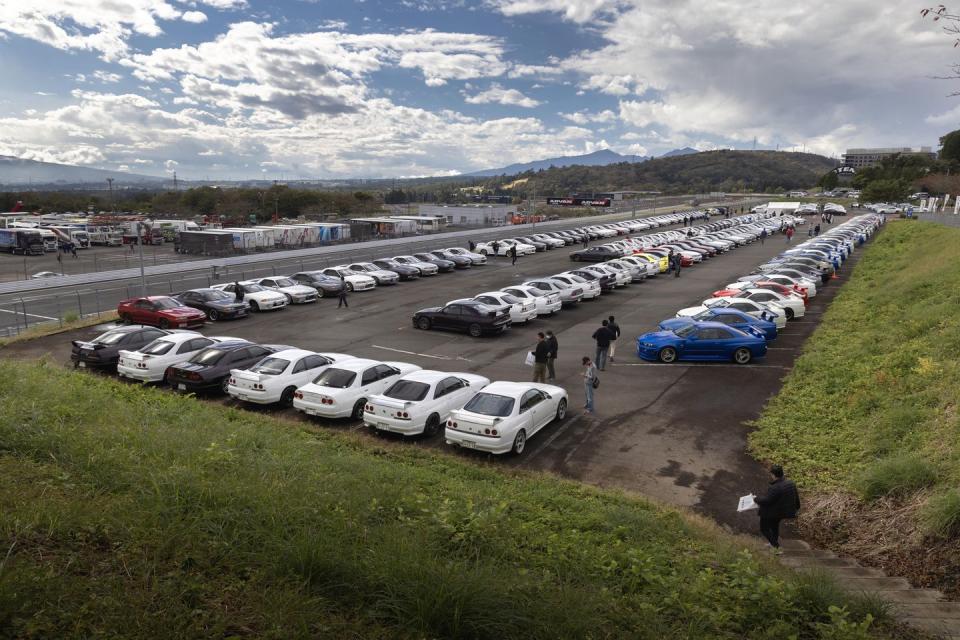
Or maybe you'll encounter something familiar in an unfamiliar place, like an American muscle car lit by the orange glow of Tokyo Tower. It arrived first as a low thump, then bubbled up into the choppy burps of a pushrod V-8. The empty parking lot lit up as a '70 Plymouth 'Cuda, as tangerine as the tower above, pulled in and came to a squeaky, wet-braked halt. "Hi," said the driver, Ishii "Mitsu" Mitsubishi, as he leaned over to unlock the passenger's door. We'd never met, but a friend of a friend of a friend had connected us after I said I wanted to explore the Tokyo car community. When Mitsu mentioned classic cars, I pictured a Nissan Fairlady Z or an early-'70s Toyota Celica. I was not imagining an American muscle machine with a 440-cubic-inch V-8 and a six-pack. "I went to school in the States, so I bought an American car," Mitsu told me as Shaffer and I squeezed into the Plymouth. "That was in the '90s. I'm 56 now," he added. "Buy an American car. It keeps you younger." Then we were on the road, roaring through tunnels, flashing past the glassy buildings alongside the overpasses, living out the Tokyo Expressway Music Rally from the Gran Turismo 7 video game—which I swore I wouldn't reference in this story, but how could I not when it was exactly like that?
Since long before this visit, I've admired Japanese art, the way the classical painters captured movement and texture with watered brush-strokes and the evolution of that stop-motion action in modern manga and anime. Then I got to Japan, and the landscape really does roll away in washes of blue and lavender. Persimmons pop like little flames against ink-black branches. The light in the city streaks and freezes like a panel out of the automotive-themed manga Shakotan Boogie. I'd thought Japanese artists were impressionists, but they're photorealists.
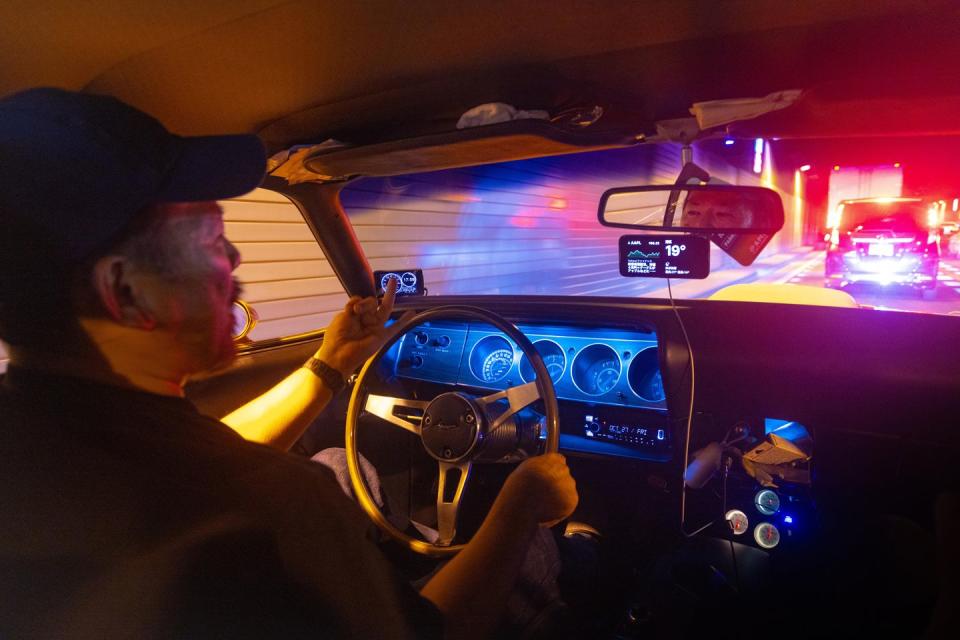
I could have happily watched the city blur through the windshield all night, but we had places to be. Our destination was the Daikoku Parking Area under the Shuto Expressway. Of all of Tokyo's automotive hubs, Daikoku is the most famous. Most evenings and weekend mornings, the lot fills with cars of every description. Exotics bedazzled with rhinestones, ground-scraping kaido racers with splitters like snowplow blades, classic Hondas, modded sport compacts—makes and models come together like wildlife around a watering hole. The challenge of attending Daikoku is that it borders a police station, so every night, the officers eventually lose patience with the crowds and send everyone home. This could happen hours into the meet or minutes, depending on the mood of the Man, so a Daikoku night is a fragile social proposition. It's fine if you drove in with your crew, because you all can just head to the next destination, but if you've somehow managed to convince a cabby to drop you off, you'll find it much harder to get one to pick you up. Daikoku's popularity might be its undoing, as stranded and ill-behaved tourists bring unwanted attention to the formerly under-the-radar meeting spot. Like influencers in a field of wildflowers, we must be respectful lest we crush what we love.
Because one never knows how long a Daikoku meet might last, the experienced gather ahead of time so they can cruise in together, park together, and get kicked out together. "Plus, you look cooler in a group," said Mitsu. We met his party at a truck stop bordering the expressway, where Kazuyoshi "Kazu" Yoshida in a 1970 Challenger and Toshiya "Toshi" Suzuki in a '71 'Cuda waited for us. A few minutes later, Ayaka Hidaka pulled up in a blacked-out '72 'Cuda; she told us it was her husband's car but looked every bit the badass behind the wheel. "Now we go to Daikoku," said Mitsu, waving his fish into a school and leading us back to the highway.
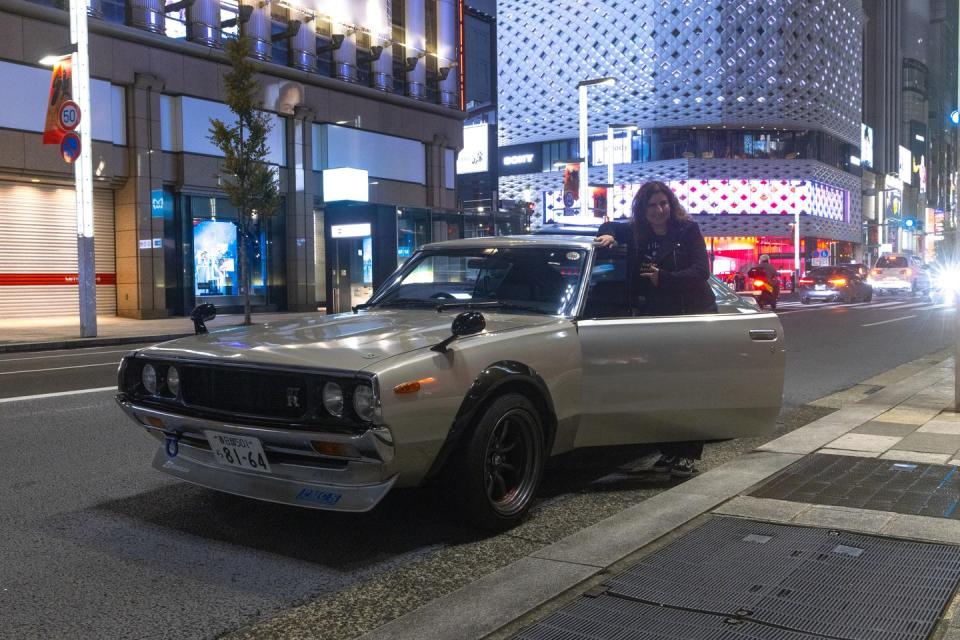
More tunnels, more lighting strobing over the long hoods and chrome trim. Our V-8 choir got a soprano addition as a Ferrari 458 blasted past. A group of little vans outlined in neon rolled by like a handful of tossed dice. The freeway split, and they headed to the right as we crossed a bridge that took us over Tokyo Bay and onto the Daikoku parking island.
There's this sound I associate with good car shows. It's not the boom and whistle of revved exhausts. It's a human sound, a belly-deep exhale encompassing admiration and respect. It means the same thing wherever you hear it: "Hot damn, look at that car!" As we rumbled into the parking lot, we heard it almost constantly. Even in Detroit, four perfect E-bodies would be a no-table lineup. In Tokyo, it was like entering a rodeo on a giraffe. Mitsu guessed there might be a hundred Challengers and Barracudas in Japan, and it felt like they were all on display that night. But ours weren't the only American cars there or the most unusual. There was a row of modern pony cars—all dropped so low you'd need a feeler gauge to measure their clearance. A red Lancia Delta Integrale sat next to a matte-blue R35 GT-R with a wing you could host a banquet on. Kazu pointed out a row of lowered Toyota s edans. "Very popular for drifting," he said. "Rear-wheel drive." The Ferrari from the tunnel drove by and threw us a rev of recognition. "The enemy," said Mitsu, without real heat.
Somehow, we managed to park all four Mopars and even find space to squeeze in a straggler, Aihara "Mori" Morihiro, in another 1970 'Cuda. Dapper in a pinstriped suit, he eyed a row of Porsche GT3s in the corner. "His day job," said Mitsu. "He sells Porsches." I never had a chance to find out how a Porsche salesman ended up in a Plymouth because the loudspeakers came on with the official police announcement: closing up, time to go. Engines fired up, scissor doors lowered, and air springs hissed as everyone politely, if not exactly hurriedly, prepared to leave. If the 'Cuda crew spun some tire on the exit, I blame the rain.
Since Daikoku often closes early, it's common practice to reconvene with your pals at a second location. For us, that was the hip neighborhood of Shibuya on the west side of Tokyo. There, we added another muscle car to our parade, this time a native: a 1971 Nissan Skyline GT-X belonging to Shinji, whose full name I never caught over the sound of muscle-car exhaust. (For the record, Shinji also owns a 'Cuda.) The Skyline fit in just fine with the school of Barracudas, balancing the latter's low boom with sassy down-shift exhaust pops.
Shibuya is all hills and narrow alleys, teenagers on scooters, and showoffs in supercars. It's a serious test of any classic car, and I was impressed that there were no issues with overheating, slipping clutches, or stumbling carbs as we sat in traffic. Car ownership of any kind is a big commitment in Japan. The expressways are all toll roads, the inspections are draconian, registration fees go up with engine displacement and a car's age, and an owner must prove they have space to park a new vehicle to register it. Add in twisty streets and busy intersections, and it's even more amazing that so many people take on the challenge of maneuvering their machines around town. The payoff is the neon wash of Yokohama in your rearview mirror as you leave Daikoku or the blur of underglow from your fellow racers as you turn the city to light trails with a push of the pedal.
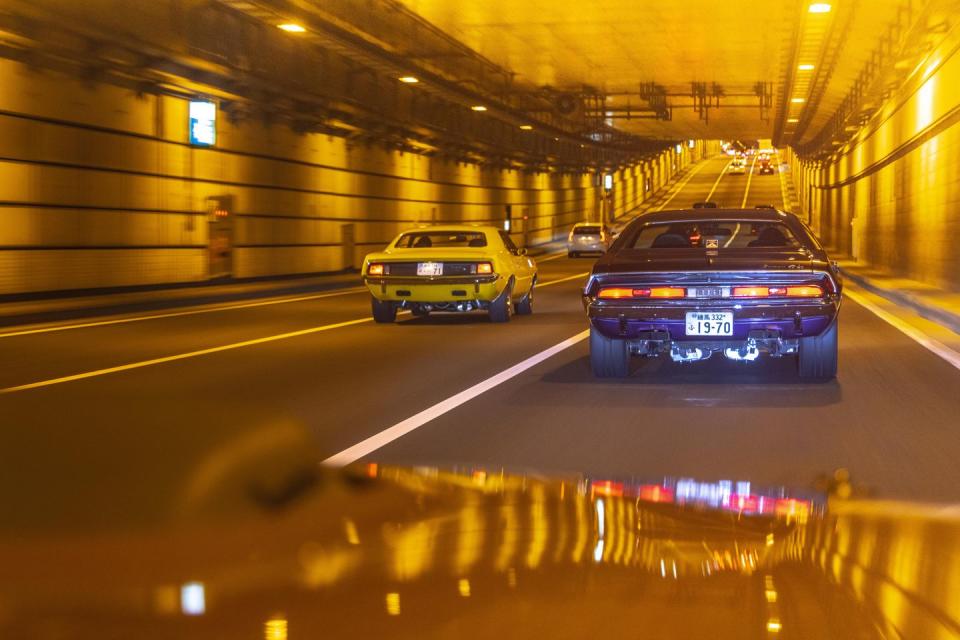
You Might Also Like

